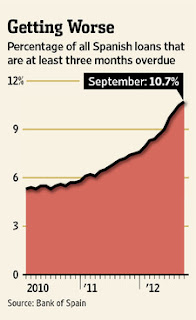Directly and indirectly, the housing bust that began in 2007
put “the bailout” on the map in the lexicon of industrial policy both in Europe
and North America. Whereas in the U.S., few restrictions were placed on the
recipients, the E.U.’s first €37 billion ($47.9 billion) for Spain’s banking
sector required the four major state banks “to make sharp cuts in their balance
sheets and payrolls,” according to the Wall Street Journal. Bankia, the largest
of the banks to be bailed out, planned to cut its number of employees by more
than 6,000, close more than 1,000 branches, pass on any further real-estate
lending, and reduce its assets by €50 billion as the bank focuses on retail
banking—getting back to the knitting, as it were. Presumably the bankers were
not allowed to grant themselves bonuses as a condition of the bailout. If so,
it would differ appreciably from the U.S. bailout of Wall Street banks.
The full essay is at Essays on the E.U. Political Economy, available at Amazon.

